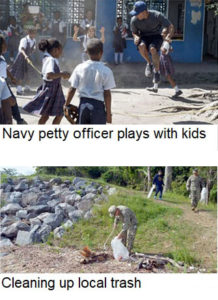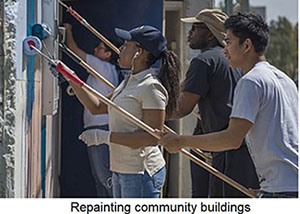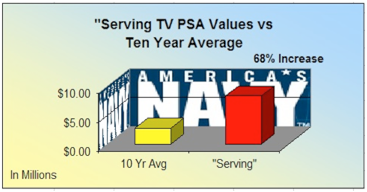REPOSITIONING THE U.S. NAVY’S PSA PROGRAM

In our ten years of working with the U.S. Navy Recruiting Command, one of the more controversial recommendations we made was to re-position its PSA program, focusing less on a strong recruiting message and emphasizing its community service work.
 There were several reasons for our recommendation and it helped to generate millions of dollars in additional PSA support. Some of them included:
There were several reasons for our recommendation and it helped to generate millions of dollars in additional PSA support. Some of them included:
- Navy was buying airtime to generate leads, thus we believed their PSA strategy should, and had to be different to get their PSAs on the air.
- In surveys with TV public service directors, they told us that they wanted PSAs about important local community issues and military recruiting PSAs did not conform to that criteria.
- Often the same TV spots that were paid, were also being submitted as PSAs. If a station is getting paid to air a commercial, why would they use the same message and give the time away free?
Navy’s Community Service Program
Our goal was to find a way to get Navy’s message out to gatekeepers in a format that both represented Navy’s recruiting interests, as well as those of the local gatekeeper. In doing research on programs that might lend themselves to a viable PSA strategy, we learned about the Navy’s Community Service Program (CSP).
 The CSP consists of Navy volunteers working in the areas of physical fitness, environmental cleanup, tutoring and mentoring at local schools, meal preparation for disadvantaged individuals, and anti-drug programs performed at the community level. This program appeared to be the perfect solution to our dilemma.
The CSP consists of Navy volunteers working in the areas of physical fitness, environmental cleanup, tutoring and mentoring at local schools, meal preparation for disadvantaged individuals, and anti-drug programs performed at the community level. This program appeared to be the perfect solution to our dilemma.
Knowing this was the answer to our problem, we convinced Navy to focus its future PSA efforts on this unique community program. There was some internal controversy over this change in strategy, due to the fact that the CSP messages did not impart a strong recruiting message.
 However, our belief was that Navy’s paid advertising already fulfilled that marketing objective, and the PSAs should have a message that was relevant to local communities, because that’s what gatekeepers wanted. Navy advertising staff agreed to test our theory by creating a series of TV PSAs around the Community Service Program.
However, our belief was that Navy’s paid advertising already fulfilled that marketing objective, and the PSAs should have a message that was relevant to local communities, because that’s what gatekeepers wanted. Navy advertising staff agreed to test our theory by creating a series of TV PSAs around the Community Service Program.
In their PSAs which described how Navy personnel were helping strengthen local communities, they also had scenes about how Navy defended us from foreign threats, thus the themeline of “Serving America Twice”.
Evaluation
Not long after the campaign was launched, our repositioning strategy began to pay dividends. This graph uses evaluation data from the A.C. Nielsen SIGMA tracking system.
 The bar on the left shows a ten-year average of values where stronger recruiting messages were shown. The bar on the right shows the value of the first CSP PSA campaign, which generated 68 percent more TV PSA support than the recruiting messages, and this data was further reinforced by increased exposure in other media as well.
The bar on the left shows a ten-year average of values where stronger recruiting messages were shown. The bar on the right shows the value of the first CSP PSA campaign, which generated 68 percent more TV PSA support than the recruiting messages, and this data was further reinforced by increased exposure in other media as well.
Key Conclusions
- By demonstrating the many positive contributions that Navy makes to communities – and the nation as a whole – the Navy generated a positive image supporting their paid recruiting messages.
- Their CSP PSA messages were delivered in a much less expensive venue than its paid advertising program
- They were able to obtain third-party media endorsement to help bolster its image.
- The CSP PSAs provided a tremendous boost to Navy morale, because sailors knew they were doing something to help improve the welfare of their local communities, while keeping the bad guys away from our shores.
